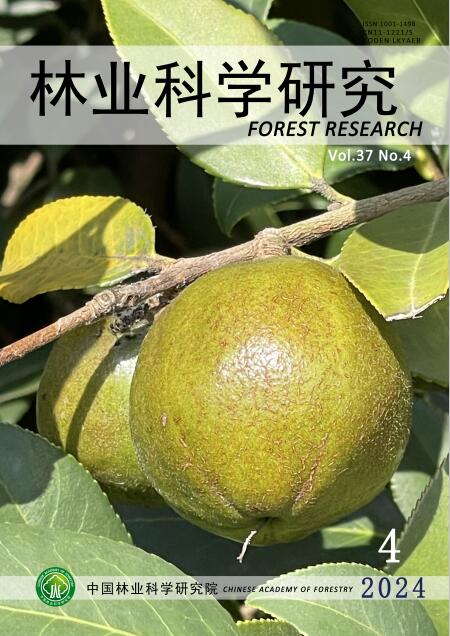碳储量在海拔和坡度上的变化
Q4 Agricultural and Biological Sciences
引用次数: 0
摘要
通过将燃料隔离在环境中并充当碳捕集器,森林在应对气候变化方面发挥着至关重要的作用。采用标准化采样方法对环境梯度上的生物结构和碳储量进行了分析。在沿样线分布20 × 20 m的36个象限图中采集数据。主图中每棵树的胸径≥5cm和总体测量高度。利用异速生长方程,测量了地上和地下的生物量,而凋落物碳则以占干生物量的50%来估算。土壤样品采用气相法获取,碳含量采用Walkley-Black法分析,容重采用烘箱干燥法分析。数据分析采用R软件的单因素方差分析。碳储量在地上、地下、凋落物生物量和土壤有机碳等环境梯度上存在显著差异。地表和地下碳储量随海拔升高呈下降趋势,土壤有机碳和升碳随海拔升高呈上升趋势。地上、地下平均碳储量分别为156.60 t C ha-1和31.32 t C ha-1,凋落物碳储量和土壤有机碳储量分别为2.72 t C ha-1和125.86 t C ha-1。结果表明,加拉-木基塔尔森林的总碳储量密度为316.6±67.15 t C ha-11。同样,在地上生物量中,碳含量为49.5%,地下生物量为9.9%,凋落物碳含量为0.9%,土壤有机碳含量为39.8%(0-30厘米深)。本文章由计算机程序翻译,如有差异,请以英文原文为准。
Editorial Note on Variation of carbon stock over altitudinal and slope gradients
By sequestering fuel in the environment and acting as a carbon trap, forests play a crucial role in battling climate change. The structure of the organisms and the carbon stock were analyzed using a standardized sampling approach over environmental gradients. In the 36 quadrant plots of 20 x 20 m each spread along transect lines, data was collected. Breast diameter ≥ 5cm and overall measured height for each tree in the main map. Using the allometric equation, above and below land biomass was measured, while the litter carbon was estimated as carbon by taking 50 percent of dry biomass. Soil samples were obtained using an auguring process and carbon was analyzed using the Walkley-Black method, while bulk density was analyzed using the oven-dried method. The data was analyzed using R software's one-way ANOVA. The carbon stocks showed distinct differences in environmental gradients in the aboveground, belowground, litter biomass and soil organic carbon. The carbon stock above and below ground has shown a declining pattern along with rising altitude, although organic soil carbon and liter carbon showed a rising pattern along with altitude rise. The mean above and below field carbon stocks were respectively 156.60 t C ha-1 and 31.32 t C ha-1 while the stocks of litter carbon and soil organic carbon were respectively 2.72 t C ha-1 and 125.86 t C ha-1. The Gara-Mukitar forest's overall carbon stock density was found to be 316.6±67.15 t C ha-11. Similarly, in the above ground biomass, 49.5 percent of carbon was found, 9.9 percent in underground biomass, 0.9 percent in litter carbon and 39.8 percent in soil organic carbon (0-30 cm deep).
求助全文
通过发布文献求助,成功后即可免费获取论文全文。
去求助
来源期刊

林业科学研究
Environmental Science-Ecology
CiteScore
0.90
自引率
0.00%
发文量
4834
期刊介绍:
Forestry Research is a comprehensive academic journal of forestry science organized by the Chinese Academy of Forestry. The main task is to reflect the latest research results, academic papers and research reports, scientific and technological developments and information on forestry science mainly organized by the Chinese Academy of Forestry, to promote academic exchanges at home and abroad, to carry out academic discussions, to flourish forestry science, and to better serve China's forestry construction.
The main contents are: forest seeds, seedling afforestation, forest plants, forest genetic breeding, tree physiology and biochemistry, forest insects, resource insects, forest pathology, forest microorganisms, forest birds and animals, forest soil, forest ecology, forest management, forest manager, forestry remote sensing, forestry biotechnology and other new technologies, new methods, and to increase the development strategy of forestry, the trend of development of disciplines, technology policies and strategies, etc., and to increase the forestry development strategy, the trend of development of disciplines, technology policies and strategies. It is suitable for scientists and technicians of forestry and related disciplines, teachers and students of colleges and universities, leaders and managers, and grassroots forestry workers.
 求助内容:
求助内容: 应助结果提醒方式:
应助结果提醒方式:


